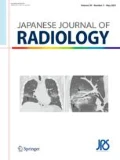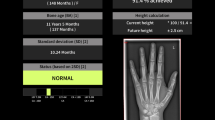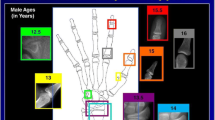Abstract
Purpose
To evaluate the agreement between observers using Greulich-Pyle (GP) and Gilsanz-Ratib (GR) methods, between four specialities (radiology, pediatrics, pediatric endocrinology and pediatric radiology) and between observers and automated tool in the bone age estimation.
Materials and methods
A total of 99 observers participated in this questionnaire-based study. BoneXpert was used for the automated tool. Experienced, senior, and junior observers were defined by their experience, and the bone age determined by experienced observers was regarded as the ground truth. Agreement between observers was evaluated using the coefficient of variance (CV) and intraclass correlation coefficient (ICC), and they were reevaluated after adding BoneXpert to the observers. Agreement of BoneXpert, the senior, and the junior observers was also evaluated using the root-mean-square-error (RMSE) values and Blant Altman method by comparing with the ground truth.
Results
The CV ranged from 4.98% to 22.08%. The ICC were 0.980 for GP, 0.980 for GP and BoneXpert, 0.973 for GR, and 0.976 for GR and BoneXpert, and the ICC between four specialities ranged form 0.963 to 0.990. BoneXpert tool had the lowest RMSE values (0.504 years for GP atlas).
Conclusion
Automated bone age estimation showed comparable results with GP and GR methods and its utilization may decrease inter-observer variability.

Similar content being viewed by others
References
Martin DD, Wit JM, Hochberg Z, Savendahl L, van Rijn RR, Fricke O, et al. The use of bone age in clinical practice: part 1. Horm Res Paediatr. 2011;76(1):1–9.
Martin DD, Wit JM, Hochberg Z, van Rijn RR, Fricke O, Werther G, et al. The use of bone age in clinical practice: part 2. Horm Res Paediatr. 2011;76(1):10–6.
Greulich WW, Pyle SI, Todd TW. Radiographic atlas of skeletal development of the hand and wrist. Stanford university press Stanford; 1959.
Gilsanz V, Ratib O. Hand bone age: a digital atlas of skeletal maturity. Springer Science & Business Media; 2005.
Thodberg HH. Clinical review: an automated method for determination of bone age. J ClinEndocrinolMetab. 2009;94(7):2239–44.
Tarim O. Height predictions by Bayley-Pinneau method may misguide pediatric endocrinologists. Turk J Pediatr. 2013;55(5):485–92.
Tajmir SH, Lee H, Shailam R, Gale HI, Nguyen JC, Westra SJ, et al. Artificial intelligence-assisted interpretation of bone age radiographs improves accuracy and decreases variability. Skeletal Radiol. 2019;48(2):275–83.
Gyftopoulos S, Lin D, Knoll F, Doshi AM, Rodrigues TC, Recht MP. Artificial intelligence in musculoskeletal imaging: current status and future directions. AJR Am J Roentgenol. 2019;213(3):506–13.
Kaplowitz P, Srinivasan S, He J, McCarter R, Hayeri MR, Sze R. Comparison of bone age readings by pediatric endocrinologists and pediatric radiologists using two bone age atlases. PediatrRadiol. 2011;41(6):690–3.
De Sanctis V, Di Maio S, Soliman AT, Raiola G, Elalaily R, Millimaggi G. Hand X-ray in pediatric endocrinology: skeletal age assessment and beyond. Indian J EndocrinolMetab. 2014;18(Suppl 1):S63-71.
Bunch PM, Altes TA, McIlhenny J, Patrie J, Gaskin CM. Skeletal development of the hand and wrist: digital bone age companion-a suitable alternative to the Greulich and Pyle atlas for bone age assessment? Skeletal Radiol. 2017;46(6):785–93.
van Rijn RR, Thodberg HH. Bone age assessment: automated techniques coming of age? ActaRadiol. 2013;54(9):1024–9.
Santos C, Ferreira M, Alves FC, Cunha E. Comparative study of Greulich and Pyle Atlas and Maturos 4.0 program for age estimation in a Portuguese sample. Forensic Sci Int. 2011;212(1–3):276.e1-7.
Lin FQ, Zhang J, Zhu Z, Wu YM. Comparative study of Gilsanz-Ratib digital atlas and Greulich-Pyle atlas for bone age estimation in a Chinese sample. Ann Hum Biol. 2015;42(6):523–7.
Schmidt S, Nitz I, Ribbecke S, Schulz R, Pfeiffer H, Schmeling A. Skeletal age determination of the hand: a comparison of methods. Int J Legal Med. 2013;127(3):691–8.
Dahlberg PS, Mosdol A, Ding Y, Bleka O, Rolseth V, Straumann GH, et al. A systematic review of the agreement between chronological age and skeletal age based on the Greulich and Pyle atlas. EurRadiol. 2019;29(6):2936–48.
Acknowledgements
We acknowledge that Visiana, the producer of BoneXpert, gave us free access to the BoneXpert software for this study without any conditions regarding the content of the paper (a so-called unrestricted Grant).
Funding
No funding was received.
Author information
Authors and Affiliations
Corresponding author
Ethics declarations
Conflict of interest
The authors declare that they have no conflict of interest.
Ethical approval
The study was approved by the ethics committee of the Erzincan University.
Additional information
Publisher's Note
Springer Nature remains neutral with regard to jurisdictional claims in published maps and institutional affiliations.
Electronic supplementary material
Below is the link to the electronic supplementary material.
About this article
Cite this article
Koc, U., Taydaş, O., Bolu, S. et al. The Greulich-Pyle and Gilsanz-Ratib atlas method versus automated estimation tool for bone age: a multi-observer agreement study. Jpn J Radiol 39, 267–272 (2021). https://doi.org/10.1007/s11604-020-01055-8
Received:
Accepted:
Published:
Issue Date:
DOI: https://doi.org/10.1007/s11604-020-01055-8




